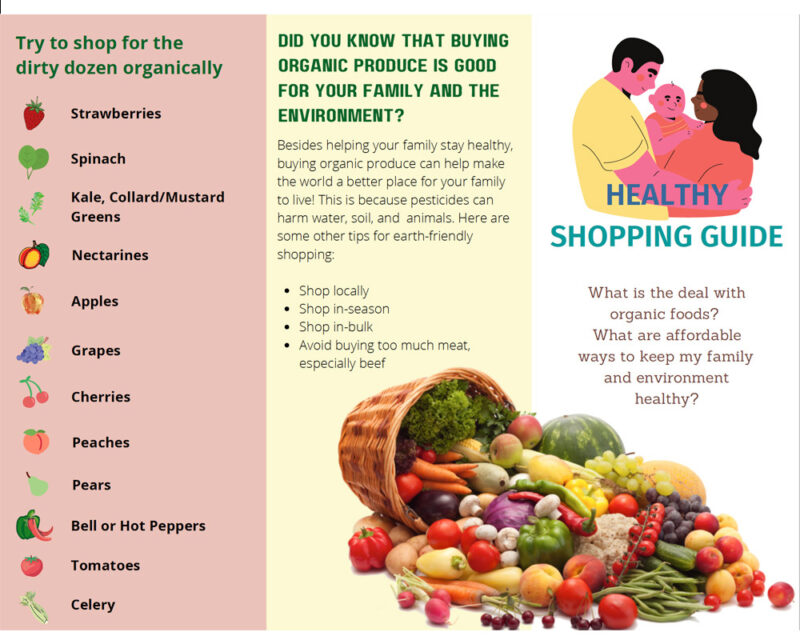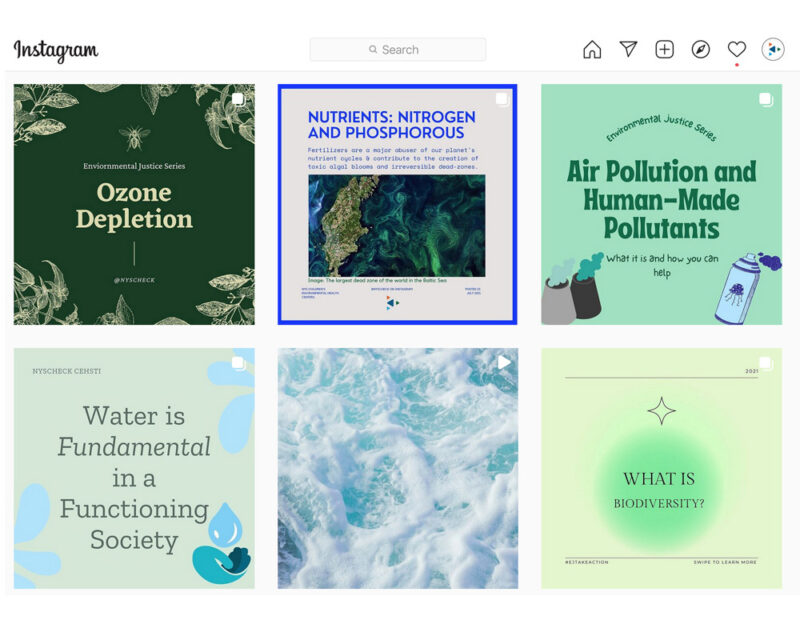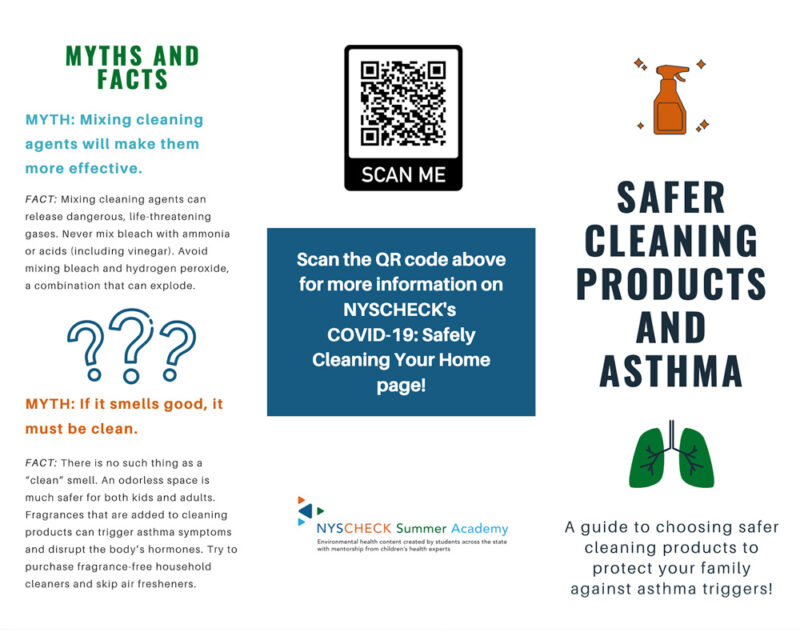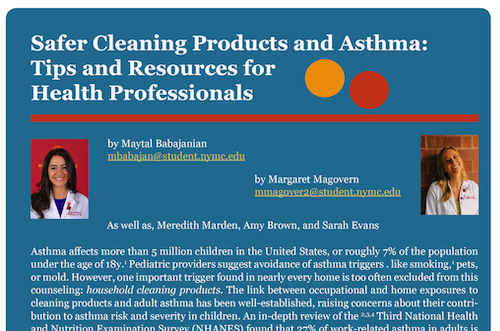Environmental health content created by students across the state with mentorship from children’s health experts.
Students enrolled in the Summer Academy were expected to spend an additional ~ 60 minutes per week working in small group teams (approximately 4-5 students/group) on their assigned advocacy project. For each group, 1-2 faculty mentors were assigned to each topic. These small group teams were largely driven by the student project-initiated goals and are supported by the faculty mentors and course facilitators.
The scholarly advocacy projects were focused on areas of priority for New York State:
- Climate Change & Environmental Justice
- Safer Cleaning & Disinfectant Products
- PFAS and Similar Chemicals
Climate Change and Environmental Justice Group
Led by Dr. Sandra Jee and Dr. Caroline Kirby
Trainees in the Climate Change and Environmental Justice Advocacy Group learned about climate change effects on child and family health. We spent the first few weeks getting to know all group members by having trainees share power point slides that highlighted their personal and professional/school affiliations. Over the course of our weekly meetings, we had four guest speakers who shared their personal stories about how they became engaged in climate change work, and who shared some of the work that they have done. Didactic information ranged from international work in Borneo with Orangutans to promote sustainability, to local work engaging students in forming school and town-based climate change groups, and also calling local politicians to engage in direct political advocacy efforts.
Projects from this Climate Change and Environmental Justice Advocacy Group ranged from creation of two infographics promoting sustainable water and farming practice, to educating about ways that our food choices can impact the environment. Students collaborated on a tri-fold brochure to distribute, which highlighted the Environmental Work Group identified fruits and vegetables that are the “Dirty Dozen” and the “Clean Fifteen” to minimize pesticide exposure. Students also created multiple Instagram posts, and shared plant-based recipes and ideas for cooking and eating sustainably.
Group work discussed some of the movies and reading materials and didactic presentations shared during weekly meetings.
Subgroup – Brochure
Participants:
Aliyyah Hamid – Long Island – High School – HBCAC
Ashley Moon – Long Island – High School HBCAC
Anastassia Sunday – Hudson Valley – Med School
Kristen Sportiello – Rochester – Med Student
Harry Hall – Rochester – High School
Shea McGrinder – Hudson Valley – Med Student
Subgroup – Instagram Campaigns
Participants:
Huda Ayaz – Long Island – High School – HBCAC
Emily Roberts – Long Island – High School – HBCAC
Maliha Ayaz – Long Island – High School – HBCAC
Aimee Koestler – Rochester – College
Sydney Schweber – Rochester – College
Tatiana Amaye-Obu – Buffalo – Med Student
Caroline Kirby – Rochester – General Pediatric Fellow
Safer Cleaning and Disinfecting Group
Led by Dr. Sarah Evans
Trainees in the Safer Cleaning and Disinfecting Advocacy group conducted a review of the health concerns associated with the use of cleaning chemicals. Recognizing that the use of potentially harmful chemicals has increased dramatically during the COVID-19 pandemic, trainees developed tools to educate both pediatricians and families of children with asthma about safer cleaning and disinfecting. These include a waiting room poster and brochure for use in pediatric asthma clinics as well as a video to engage children in making safe DIY cleaners at home. Students also published a guidance for clinicians, “Safer Cleaning Products and Asthma: Tips and Resources for Health Professionals”, in the American Academy of Pediatrics New York Chapter 1 AAP in Action Newsletter. Lastly, trainees researched how legislation and regulations might be strengthened to prevent the use of harmful disinfectants in schools, with plans to present to New York State decision makers in the 2021-2022 legislative session.
Safer Cleaning Products and Asthma – Brochure, Poster, and Guidance for Clinicians
Participants:
Meredith Marden – NYC Sinai – College
Priscilla Tran – Hudson Valley – Med Student
Joseph Mohrbacher – Hudson Valley – Med Student
Margaret Magovern – Hudson Valley – Med Student
Justin Lanot – Long – Island – High School – HBCAC
Sara Glick – MD, Pediatrician – Swiss Tropical and Public Health Institute, Switzerland, MSSM
Subgroup – Safer Cleaning DIY Video
Participants:
Max Erez – NYC Sinai – College
Nina Silverstein – Hudson Valley – College
Subgroup – Safer Cleaning and Disinfecting Legislation and Regulations
Participants:
Erin Torres – Long Island – High School – HBCAC
Olivia Polinsky – Long Island – High School – HBCAC
Ian J. Bezdicek – Hudson Valley – College
Nina Silverstein – Hudson Valley – College
PFAS and Similar Chemicals
Led by Dr. Amy Brown
The PFAS Summer Student Advocacy Subgroup focused on an advocacy audience of students and families of school aged children. Understanding that school aged children is a diverse group of learners, the students further broke down into three teams of elementary, middle and high school students to develop educational tools. The purpose of this educational resource is for families, along with their children, to learn more about what PFAS chemical are, where they are found, and why they are of concern.
As some background, PFAS (an abbreviation for per- and polyfluoroalkyl substances) are commonly known as “forever chemicals” and in 2021 are found almost ubiquitously in many commonly used products and may become concentrated as pollutants in our water systems. PFAS and the associated chemicals are man-made contaminants with emerging health related concerns. As with many chemicals, children remain highly vulnerable to the toxic effects of these pollutants. Mounting evidence now links exposure of these chemicals to untoward health effects that require urgent and immediate attention. In order for us to act together to prevent children from this adverse environmental exposure, the first step is to learn more about the nature of the concern. Through these educational modules, the students creating these platforms hope to inform families — in a child-centric fasion — about these chemical and the reason for concern.
Participants and Support:
Catlin Harris – NYC Sinai – Med Student
Anna Turner – Hudson Valley – College
Callie Toal – Hudson Valley – College
Christopher J Perrino – Hudson Valley – College
Jamie Pietropinto – Hudson Valley – College
Kirsten Damore – Hudson Valley – College
Peter Xiong – Hudson Valley – Med Student
Rebecca Starkman – Hudson Valley – Med Student
Subgroup – Grades K-5
Presenter: Amanda Sanko – Rochester – College
Subgroup – Grades 6-8
Presenter: Jessica Flores – Buffalo – Med Student
Subgroup – Grades 9-12
Lead Participants:
Andrea Ndoka – NYC Sinai – Med Student
JennaGarrett – Hudson Valley – Med Student




